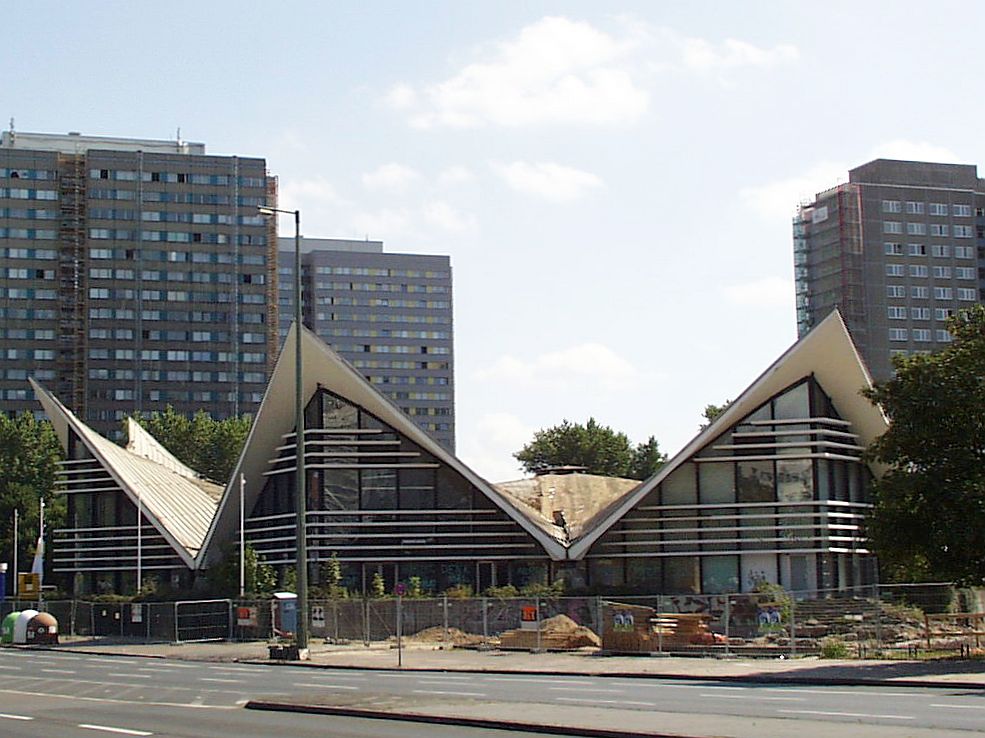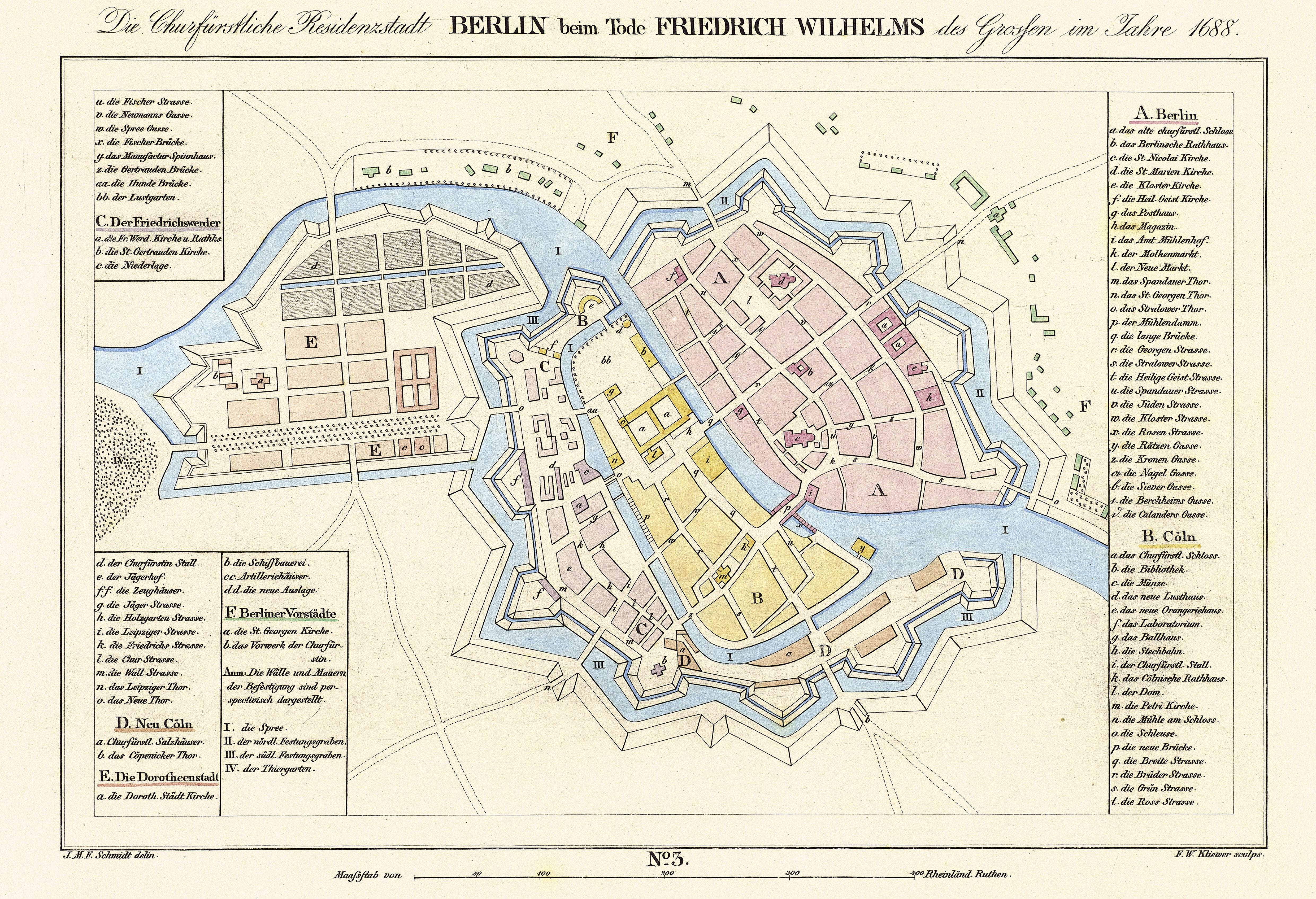|
Fischerinsel
Fischerinsel (, ''Fisher Island'') is the southern part of the island in the River Spree which was formerly the location of the city of Cölln and is now part of central Berlin. The northern part of the island is known as Museum Island. Fischerinsel is normally said to extend south from Gertraudenstraße and is named for a fishermen's settlement which formerly occupied the southern end of the island. Until the mid-twentieth-century it was a well preserved pre-industrial neighbourhood, and most of the buildings survived World War II, but in the 1960s and 1970s under the German Democratic Republic it was levelled and replaced with a development of residential tower blocks. History The original settlement of fishermen and other boatmen and their families was part of Cölln from 1237 on. The neighbourhood, which occupies approximately had many relatively well to do inhabitants, but during the 17th century it became a crowded neighbourhood of poor people and came to be known as the ''F ... [...More Info...] [...Related Items...] OR: [Wikipedia] [Google] [Baidu] |
Großgaststätte Ahornblatt
The Großgaststätte Ahornblatt (, ''Great Maple Leaf Restaurant'') was a building located in the Mitte district of Berlin. Built between 1971 and 1973 as part of the new Fischerinsel residential condominium project, it accommodated a self service restaurant with 880 seats and a shopping arcade for the employees of the East German Ministry of Construction and for the workers of other nearby offices. Despite protests, the building was demolished in 2000. Background and construction The ''Ahornblatt'' was built between 1970 and 1973 along with the tall towers of the new Fischerinsel residential condominium project, and was intended to serve as its social center. The building was located on the corner of Gertraudenstraße and Fischerinsel. The ''Ahornblatt'' design came from the architects Gerhard Lehmann and Rüdiger Plaeth, following the urban concepts of Helmut Stingl. The ''Ahornblatt'' name resulted from the leaf-like, outwardly curved shape of the roof. The construction of th ... [...More Info...] [...Related Items...] OR: [Wikipedia] [Google] [Baidu] |
Cölln
Cölln () was the twin city of Old Berlin (Altberlin) from the 13th century to the 18th century. Cölln was located on the Fisher Island section of Spree Island, opposite Altberlin on the western bank of the River Spree, until the cities were merged by Frederick I of Prussia to form Berlin in 1710. Today, the former site of Cölln is the historic core of the modern Mitte locality of the Berlin-Mitte borough in central Berlin. History Cölln is first mentioned in a 1237 deed, denoting a priest Symeon of Cölln's (Symeon de Colonia) Saint Peter's Church as a witness. This date is commonly regarded as the origin of Berlin, though Altberlin on the eastern bank of the Spree river was not mentioned before 1244 and parts of modern Greater Berlin, such as Spandau and Köpenick, are even older. Cölln and Altberlin were separated only by the river Spree, linked by the ''Mühlendamm'' causeway, hence there was a close connection right from the start. Since the trade route from Magdeb ... [...More Info...] [...Related Items...] OR: [Wikipedia] [Google] [Baidu] |
Zum Nußbaum
Zum Nußbaum is a historic inn in Berlin, Germany. Formerly located in Fischerinsel, after its destruction in World War II it was recreated in the nearby Nikolaiviertel. The inn, originally located at Fischerstraße 21, was built either in 1505 or in 1705, according to different interpretations of the inscription over the cellar entrance. It was named for the nut tree which formerly stood outside it and was one of the oldest drinking establishments in the city. It was popular with tourists and had been frequented and depicted by artists such as Heinrich Zille and Otto Nagel. The inn was destroyed in an Allied air-raid in 1943, along with most of the surrounding area. It was recreated in 1987 in the nearby Nikolaiviertel as part of the East German East Germany, officially the German Democratic Republic (GDR; german: Deutsche Demokratische Republik, , DDR, ), was a country that existed from its creation on 7 October 1949 until its dissolution on 3 October 1990. In these years ... [...More Info...] [...Related Items...] OR: [Wikipedia] [Google] [Baidu] |
Nikolaiviertel
Founded about 1200, the (Nicholas' Quarter) of Alt-Berlin, together with nearby Cölln, jointly make up the reconstructed historical heart of the German capital of Berlin. It is located in Mitte locality (in the homonymous district), five minutes away from Alexanderplatz. Geography Situated on the eastern shore of the river Spree, it is bounded by the streets ''Rathausstraße'', ''Spandauer Straße'' and ''Mühlendamm''. The neighborhood itself is named for the eponymous deconsecrated Nikolaikirche ("Saint Nicholas Church") at its heart, i.e. Berlin's oldest church. History The two settlements of Old Berlin as well as Cölln on the other side of the Spree originated along an old trade route, the ''Mühlendamm'' (Mills Dam), a ford where the river could be easily crossed. The Nicholas' Church, originally a late Romanesque basilica, was erected about 1230. The area around the church with its medieval alleys in the main had been preserved throughout the centuries, until it wa ... [...More Info...] [...Related Items...] OR: [Wikipedia] [Google] [Baidu] |
Museum Island
The Museum Island (german: Museumsinsel) is a museum complex on the northern part of the Spree Island in the historic heart of Berlin. It is one of the most visited sights of Germany's capital and one of the most important museum sites in Europe. Built from 1830 to 1930 by order of the Prussian Kings according to plans by five architects, Museum Island was designated a UNESCO World Heritage Site in 1999 because of its testimony to the architectural and cultural development of museums in the 19th and 20th centuries. It consists of the Altes Museum, the Neues Museum, the Alte Nationalgalerie, the Bode-Museum and the Pergamonmuseum. As Museum Island includes all of Spree Island north of the Unter den Linden, the Berliner Dom is also located here, near the Lustgarten. To the south, the reconstructed Berlin Palace houses the Humboldt Forum museum and opened in 2020. Since German reunification, the Museum Island has been rebuilt and extended according to a master plan. In 2019, a new ... [...More Info...] [...Related Items...] OR: [Wikipedia] [Google] [Baidu] |
Hošek Contemporary
Hošek Contemporary is a gallery located on a barge in central Berlin. The gallery focuses mainly on performing arts, experimental music, installations and dance. It was founded in 2016. History Hošek Contemporary was founded by Petr Hošek in 2016. It opened its doors for the first time in Rosa-Luxemburg Strasse 26, Berlin, as a classical white cube gallery. The first exhibition to be held at the gallery was ''Tang Dynastie'' by German artist Herbert Eugen Wiegand. In 2017 the gallery moved to Oranienburgerstrasse 22 before transferring to its current location on the MS Heimatland barge a year later. Sound installations are a feature of the gallery space and events are hosted weekly. The gallery moved to its present home on board the MS Heimatland barge in 2018. The Heimatland was constructed in Germany in 1910 and was originally named the IDA. During World War II it served as a munitions transporter and was captured by British military forces towards the end of the wa ... [...More Info...] [...Related Items...] OR: [Wikipedia] [Google] [Baidu] |
Martin Grünberg
Martin Grünberg (born 1655, Insterburg, then in East Prussia, now in Russia – between 16 and 23 October 1706 or 1707Precise date of death unknown) was a German architect and master builder. Life He was active in Berlin from 1687 onwards, after several trips to France and Italy. In Berlin he took part in the construction of the Friedrichstadt and oversaw the construction in the Kurmark alongside the Electorate of Brandenburg's head architect Johann Arnold Nering, who he succeeded from 1695 to 1698, when he again became the head-architect's subordinate. These works included the building of the Schloss and Residenz buildings. Like Nering he was a representative of the Dutch Baroque style. His other designs include the Marstallgebäudes on the Unter den Linden as far as the later Dorotheenstraße (including the first Berlin Observatory), the Jungfernbrücke (formerly known as the Spreegassenbrücke) and the Sebastiankirche (later known as the Luisenstädtische Kirche). On occas ... [...More Info...] [...Related Items...] OR: [Wikipedia] [Google] [Baidu] |
Baroque Architecture
Baroque architecture is a highly decorative and theatrical style which appeared in Italy in the early 17th century and gradually spread across Europe. It was originally introduced by the Catholic Church, particularly by the Jesuits, as a means to combat the Reformation and the Protestant church with a new architecture that inspired surprise and awe. It reached its peak in the High Baroque (1625–1675), when it was used in churches and palaces in Italy, Spain, Portugal, France, Bavaria and Austria. In the Late Baroque period (1675–1750), it reached as far as Russia and the Spanish and Portuguese colonies in Latin America. About 1730, an even more elaborately decorative variant called Rococo appeared and flourished in Central Europe. Baroque architects took the basic elements of Renaissance architecture, including domes and colonnades, and made them higher, grander, more decorated, and more dramatic. The interior effects were often achieved with the use of ''quadratura'', or ... [...More Info...] [...Related Items...] OR: [Wikipedia] [Google] [Baidu] |
Heinrich Zille
Rudolf Heinrich Zille (10 January 1858 – 9 August 1929) was a German illustrator, caricaturist, lithographer and photographer. Childhood and education Zille was born in Radeburg near Dresden, son of watchmaker Johann Traugott Zill (''Zille'' since 1854) and Ernestine Louise (born ''Heinitz'', daughter of a miner from the Ore Mountains). His father had originally been a blacksmith, however, being technically skilled, had gone on to become a watchmaker, goldsmith and inventor of tools. Zille spent his early years in Potschappel. His childhood was not without trouble. His father was incarcerated several times in debtors' prison and creditors harassed the family so much that the young Zille was often sent to live with his grandmother. In 1867 the family left town because of their debts and moved to Berlin. While still in school, the young Zille began to take drawing lessons. The teacher was supportive, and during a discussion of his future career aspirations, encouraged Zille to b ... [...More Info...] [...Related Items...] OR: [Wikipedia] [Google] [Baidu] |
Waffen-SS
The (, "Armed SS") was the combat branch of the Nazi Party's ''Schutzstaffel'' (SS) organisation. Its formations included men from Nazi Germany, along with Waffen-SS foreign volunteers and conscripts, volunteers and conscripts from both occupied and unoccupied lands. The grew from three regiments to over 38 division (military), divisions during World War II, and served alongside the German Army (Wehrmacht), German Army (''Heer''), ''Ordnungspolizei'' (uniformed police) and other security units. Originally, it was under the control of the (SS operational command office) beneath Heinrich Himmler, the head of the SS. With the start of World War II, tactical control was exercised by the (OKW, "High Command of the Armed Forces"), with some units being subordinated to (Command Staff Reichsführer-SS) directly under Himmler's control. Initially, in keeping with the racial policy of Nazi Germany, membership was open only to people of Germanic origin (so-called "Nazi racial theor ... [...More Info...] [...Related Items...] OR: [Wikipedia] [Google] [Baidu] |






